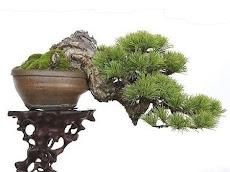
Photo by:Pixellens
Story by:Kurt Schefken
The fine art of Bonsai has been around in the Japanese and Chinese cultures for hundreds of years. Over the last half century it has become popular in the United States as well. It takes a long time to grow a bonsai tree, even though they are very small. The project needs care and patience, as well as some artistic ability. The bonsai must blend in with its container to create a visual portrait of a full grown tree.
Usually bonsai is a hardy tree that is forced to grow in a small pot. Some tropical plants such a a pomegranate have been used successfully as bonsai. Trees or plant with small foliage must be used or the leaves will look out of proportion. Outstanding bonsai have been made from zeikova, ginkgo and some pies and maples. Plants that would be considered unattractive in other situations, such as runty plants with twisted or gnarled trunks and branches are great candidates for bonsai. You can buy such plants in a nursery, or go on a hunt in the woods for them.
The bonsai pot is an integral part of the design. They can be as small as 2 inches wide, or as large as 25 inches. Some are baked clay, and others are glazed. They need to have drainage holes.
The soil for bonsai should be able to hold moisture. Most people start with a coarse layer of soil at the bottom and add fine humus rich soil at the top. Usually moss, or spreading plants such as helxine soleirolii is placed on top of the soil, or even small stones.
The root ball of the small tree should be completely cleaned of soil and the roots cut back drastically. This will keep the plant dwarfed. Cut back the top of the tree to balance with the roots and put it in the pot, packing the soil around the roots and tree firmly. To acclimate the tree, it should be watered well and placed in dappled shade for a few weeks. Then it can be moved to full sun. If you start your bonsai in the spring, you will have more success since the light gets stronger gradually.
As the plant grows yo will have to re pot it, probably once a year. So make sure you schedule this activity so that your plant is always in the best shape possible.
Creating a bonsai is an artistic endeavor, so there is not just one way to do it but many. Pruning and cutting out new growth to achieve the exact balance you want will take trial and error and a good eye for lines. You can force the plant to bend or look warped by wrapping it with wire and pulling the branches down.
If you are fascinated by the idea of creating a bonsai, you will find that it is fairly easy to do. The tradition has a certain air of mystique, but the process is not difficult, it just takes time and patience.
Article Directory: http://www.articlecube.com
Kurt Schefken is writing mainly for http://www.insidewoodworking.com , an online publication on the topic of woodworking machinery . You can come across his contributions on workbenches and tool storage on his site.



